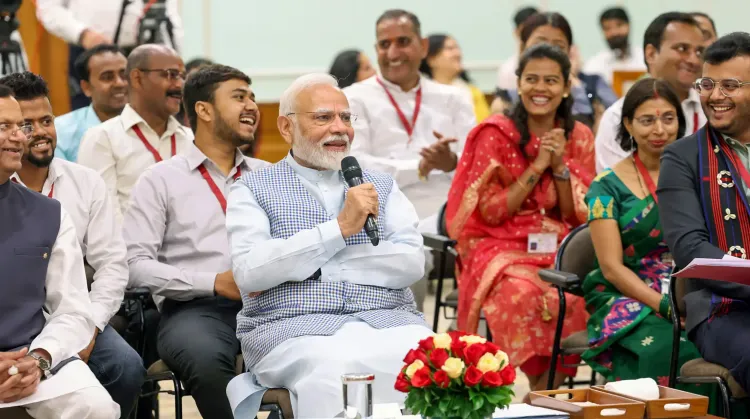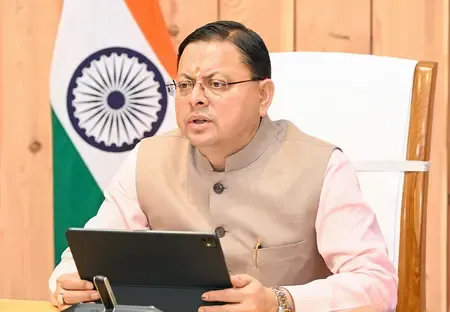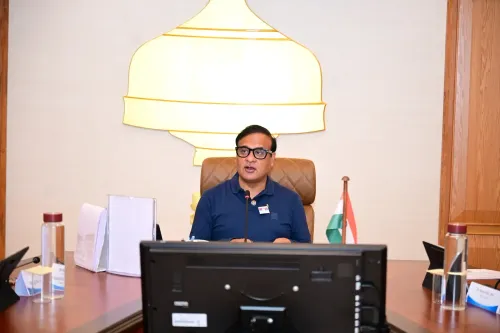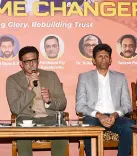PM Modi: MUDRA Revolutionizes India's Financial Landscape

Synopsis
Key Takeaways
- MUDRA has provided over 52 crore loans.
- Empowered grassroots communities through financial inclusion.
- Only 3.5% of loans have turned into NPAs.
- Part of a larger vision for financial empowerment.
- Trust in citizens’ abilities has driven success.
New Delhi, April 8 (NationPress) Prime Minister Narendra Modi emphasized on Tuesday that the Pradhan Mantri MUDRA Yojana (PMMY), initiated a decade ago on April 8, has emerged as a monumental success in empowering the impoverished at the grassroots level, with over 52 crore loans disbursed amounting to Rs 33 lakh crore.
The Prime Minister articulated that the MUDRA initiative was conceived during his extensive travels as a 'karyakarta', where he recognized the urgent need for “funding the unfunded” to help elevate the masses from poverty.
He pointed out that the scheme has democratized the financial system, as evidenced by the fact that only 3.5 percent of loans under the program have turned into NPAs.
In a post on X, the Prime Minister stated, “Sharing my interview with Economic Times, where I elaborate on the transformative potential of Mudra Yojana and why it remains crucial in our pursuit of dignity and empowerment. #10YearsOfMUDRA.”
PM Modi further clarified that the MUDRA (Micro Units Development & Refinance Agency) scheme should be viewed in a larger context, not merely as an isolated initiative.
“Even before I held any government position, I traveled extensively across the nation for decades as a karyakarta. A consistent theme I observed was the aspiration for growth among a vast majority of our population, including the poor, farmers, women, and marginalized communities. These groups possessed the entrepreneurial spirit and resilience necessary for success but were often excluded from formal banking systems,” he noted.
“Without a bank account, how can one ever visit a bank? When basic banking access is absent, the idea of funding entrepreneurship becomes a distant dream. Therefore, when people voted for us in 2014, we resolved to reshape the entire financial architecture to be more inclusive, allowing us to help fulfill their aspirations,” PM Modi remarked.
He reiterated that the initiative has fundamentally democratized the financial landscape.
“This began with 'banking the unbanked' through Jan Dhan Yojana. Once individuals who were previously marginalized became part of the formal financial ecosystem, we transitioned to 'funding the unfunded' through the MUDRA Yojana and 'insuring the uninsured' via the Jan Suraksha scheme portfolio. Thus, MUDRA is part of a broader vision aimed at respecting, celebrating, and supporting the entrepreneurial talents, creativity, and self-reliance of grassroots individuals,” he stated.
“Through the MUDRA Yojana, our intention was to convey to every Indian that we trusted their capabilities and would act as a guarantee in their journey towards fulfilling their dreams. Trust begets trust. The response from the people has been enthusiastic, and now, with over 52 crore loans granted totaling Rs 33 lakh crore, MUDRA stands as a tremendous success,” PM Modi said.
Addressing the NPA issue within India's banking sector, PM Modi remarked: “There are two viewpoints regarding this issue. On one side is the experience from the Congress-led United Progressive Alliance era, where the banking sector was characterized by a system termed 'phone banking'. Loans were granted based on political affiliations rather than merit or stringent financial scrutiny. This created what is known as the twin balance sheet problem, leaving public sector banks burdened with stressed assets and hampering broader economic growth.”
He continued: “Conversely, we provided loans to the poor and middle class through the MUDRA Yojana, which was designed to empower small and medium entrepreneurs who lacked connections yet possessed competence and determination. Unlike the UPA’s top-heavy lending model, MUDRA focused on stimulating grassroots economic activities. Today, with over 52 crore loan accounts, MUDRA illustrates the vast scale and ambition of the initiative.”
“At the launch of this program, many prominent Congress leaders and their allies predicted that providing credit to millions of small-scale borrowers would lead to an NPA crisis. They lacked faith in the poor and middle classes of our nation. However, the results have disproved these concerns. Notably, the performance of these loans has been exceptional, with just 3.5 percent classified as NPAs. This represents an unusually low default rate in this segment globally. While the UPA's phone banking epoch left banks encumbered with toxic assets and favored a select elite, MUDRA has redirected resources to the grassroots, nurturing entrepreneurship without jeopardizing financial stability,” PM Modi concluded.










